
The Road To Morocco
From the American Midwest to North Africa
Jump toCasablanca
This page takes me from my home to Chicago by train,
then flights from there to New York City, on to Paris,
and from there to Casablanca.
Jump to my arrival
to get directly to Morocco.
From Casablanca I would travel around Morocco
on their excellent trains.
And, for places trains don't go, buses.
Yes, I was on
The Road To Casablanca,
but it wouldn't be like the Hope/Crosby/Lamour movie,
or the
Humphrey Bogart movie,
or the
Marx Brothers movie.
All of those were filmed entirely on studio lots in California,
almost 9,600 kilometers away.
None of them had any credited actors of
Arab descent or North African origin.
Chicago's
Dan Seymour
played a character in all three films,
and Chicago is about a third of the way from
Los Angeles to Casablanca.
But that's as close as those movies got to Morocco.
Here I go!
There was a nice sunrise as I walked from
my home in West Lafayette,
across the pedestrian bridge over the Wabash River
to Lafayette, and to the Amtrak train station.
That morning's train would take me to Chicago.
From there I would take a Delta flight to JFK,
then Air France to Paris and changing there
for the onward flight to Morocco.
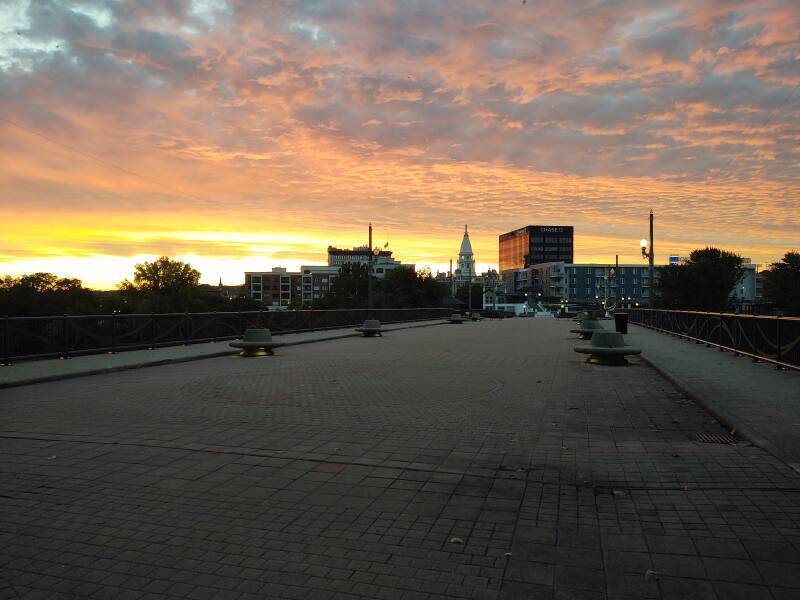
I would be a traveler in an antique land where the lone and level sands stretch far away, as Shelley wrote.
Jump toCasablanca
There isn't nearly as much history where I live, although it includes colonial misadventures as Moroccan history does. This region was home to many native tribes. The French called it the Pays des Illinois, "The Land of the People Calling Themselves the 'Illinois'". The French Voyageurs established trading posts and traveled throughout the region, trading and often starting families with the local peoples. They established a trading post near here, later upgraded in 1717 to a military fort to counter the encroaching British influence. That was Ouiatenon, the French rendering of the Miami-Illinois term Waayaahtanonki, "Place of the People of the Whirlpool".
The French withdrew around 1760, the British took over, then there was the American Revolution. In 1791 George Washington ordered a military expedition to "extirpate" the native peoples living in the large region between the Ohio and Mississippi rivers.
Battle of TippecanoeThe uncooperative natives wouldn't simply die or disappear, so in 1811 William Henry Harrison, the Governor of the Indiana Territory, led a military force to the Battle of Tippecanoe. It happened a short distance up the Wabash in the direction we're looking below. It was a nasty genocidal affair in which the U.S. forces resorted to desecrating graves of those natives who couldn't be killed because they were already dead. Harrison became, quite briefly, U.S. President, and the highway bridge in the distance here was named in his honor.

Casablanca
Harrison became the first U.S. President to die in office, just 31 days after his inauguration. It was on a cold and rainy day, he didn't wear an overcoat or hat, and he delivered what remains the longest inaugural address in American history — 8,445 words that took him two cold, wet hours to slog through.
He developed pneumonia a few days later and received the state of the art of medical care: a mustard plaster, a laxative, and cupping, followed by bloodletting until that dropped his pulse rate. His physicians then administered laudanum (a tincture of opium dissolved in ethanol), straight opium, camphor, and wine and brandy. All that led to severe diarrhea, delirium, and death. I was on my way to Tangier, where William S Burroughs wrote Naked Lunch. It sounds like Doctor Benway was on Harrison's medical staff.
Here comes my train! This is Amtrak train #50/51, The Cardinal, running between the east coast and Chicago through opioid-saturated Appalachia and Indiana. Oh, the conversations I've overheard onboard about obtaining and using opioids. They should call the train The Laudanum.
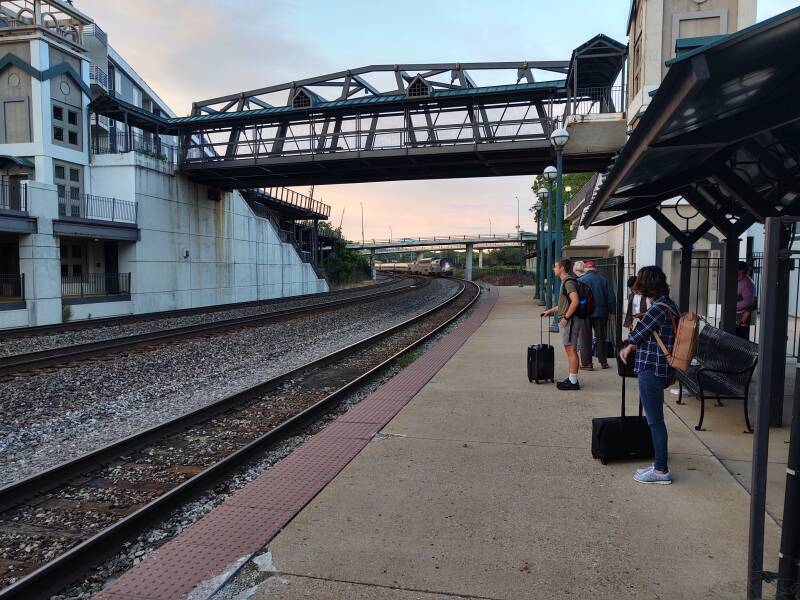
Chicago
We arrived on time at Chicago's Union Station. This is where Brian De Palma filmed a scene for his 1987 film The Untouchables.
The scene itself was a tribute to Sergei Eisenstein's 1926 Battleship Potemkin.

Here's an El train (as in "Elevated") crossing a branch of the Chicago River north of Union Station. The CTA or Chicago Transit Authority trains operate on a mix of underground and overhead tracks, with a relatively small amount of track at ground level.

At left here is the Merchandise Mart. It opened in 1930 as the largest building in the world with 4 million square feet of floor space. The Pentagon took the title in 1943 with 6.3 million. Now it's the Yiwu International Trade City in Zhejiang, China, with 4 million square meters or 6.6 Pentagons.
In the distance at center, further down the river toward Lake Michigan, are the twin Bob Newhart Towers.

Here are El tracks in The Loop. That's downtown Chicago where five CTA lines run overhead on a rectangular loop with eight stations, an area five city blocks east-west and seven north-south. Two underground lines run north-south below the Loop.
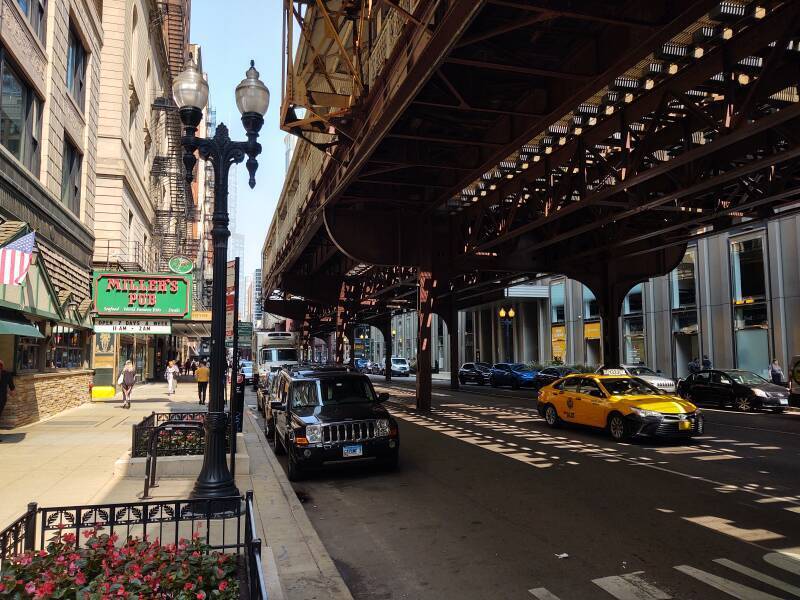
Later in the afternoon it was time to descend to the Blue Line and head toward O'Hare Airport!
A Short Stop in New York
I had a Delta flight to New York JFK, where I would change to Air France for the next two legs. I had a great view of the city. The first picture here is looking south over Manhattan. Central Park is the dark rectangle. The East River is at left, the Hudson River at right, Queens and then Brooklyn along the left border, New Jersey, Staten Island, and then New Jersey again along the right.
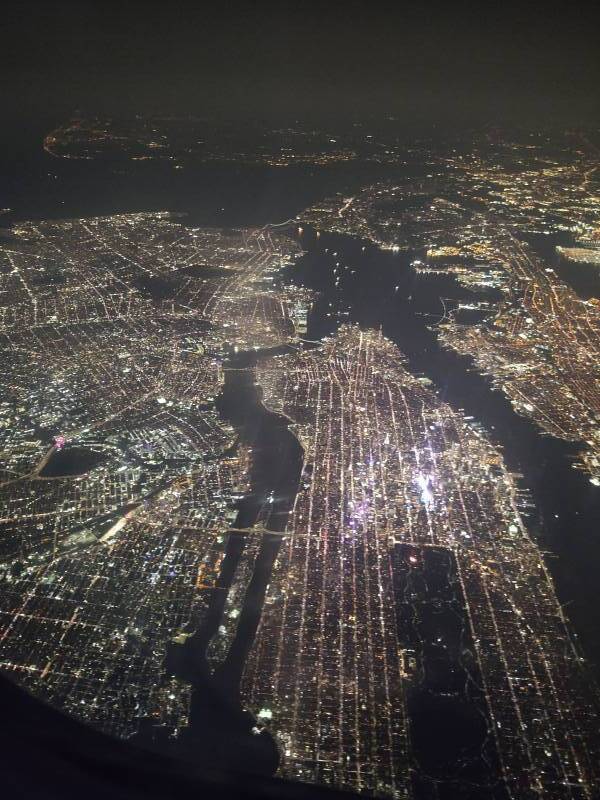
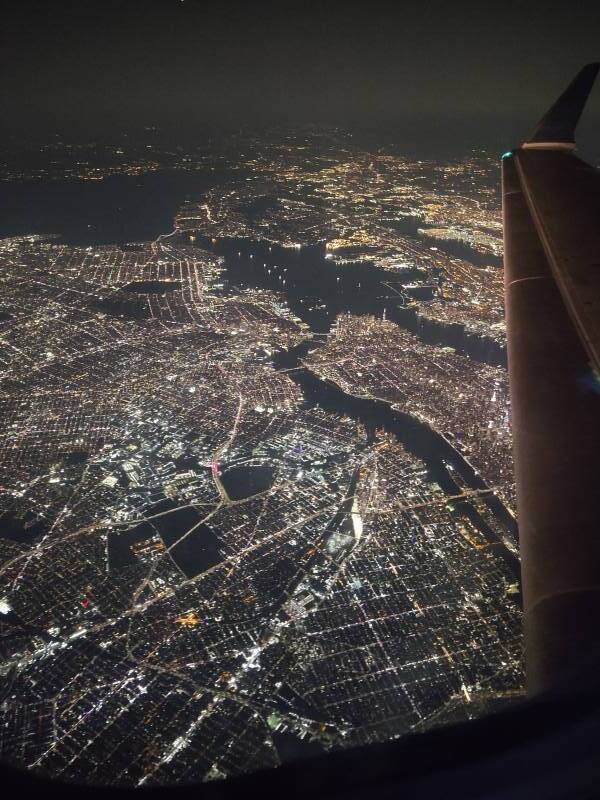
A little further along we were over Queens looking southwest.
JFK was the usual mess explained by staff stationed there to tell you how you proceed counter to what the signs say. "You see, you have landed at Terminal 4 and your next flight leaves from Terminal 1. So what you need to do is take that bus to Terminal 2 and walk from there to Terminal 1. But no, not that bus! The one behind it!"
Then at Terminal 2 one of the cleaning staff provided vague directions, which was good because there were no signs. After exiting the terminal, crossing three roadway lanes, and climbing a short staircase, I could see the first sign pointing me toward Terminal 1.
Here's how you got to Casablanca back in the day, at least if you were traveling with the U.S. Air Transport Command immediately after World War II.

U.S. Air Transport Command map showing the old routing: New York — Manchester — Stephenville — Azores — Casablanca.
I was packed into Economy class on an Air France B777-200ER from New York JFK to Paris CDG. Finally, a civilized airport. Then an Air France A320 to the equally civilized Casablanca airport.
Arrival in Casablanca
Casablanca's Mohammed V Airport was originally built for the U.S. Army Air Corps in early 1943, a few months after Operation Torch, the Allied landings in Morocco and Algeria during World War II. The U.S. used it for U.S. cargo and reconnaissance operations. The U.S. then handed it over to the Moroccan government at the end of the war.
Until... the U.S. decided they needed it back for the Cold War. It became Nouasseur Air Base and was home to U.S. Strategic Air Command B-47 nuclear-armed bombers ready to attack the Soviet Union. That led to it now having two parallel 12,205-foot runways.
The USAF had the longer-range B-52 and bases in Spain by late 1959, and agreed to leave Morroco, getting fully out by 1963.
Until... the U.S. decided they needed to use it as a Space Shuttle emergency abort landing site, given its location downrange from Florida.
But now it's all Morocco's. Totally.

Portion of Tactical Pilotage Chart G-1D from the Perry-Castañeda Library Map Collection at the University of Texas at Austin.
The Casablanca airport is described as the 4th busiest in Africa. I stand 100% behind that statement, it is described that way. But the truth in the form of rankings and statistics is flexible from here east across North Africa, Asia, and beyond that.
Take the description of Casablanca as the third-largest city in Africa after Egypt's Cairo and Alexandria. "That just shows that you can't trust Wikipedia!", people shout. Um, that was actually in a guidebook that relied on the latest official national government figures.
The Wikipedia page, on the other hand, pointed to references reporting that the Nigerian government hasn't completed a census since a time when Lagos, now a gigantic city, had only 1/8 or possibly just 1/10 its current population. No one knows how big Lagos really is. There's a similar story for Kinshasa, DRC.
And so Casablanca is certainly, by far, the largest city with the busiest airport in Morocco. And, more significantly, it's within the top few biggest cities and busiest airports in all of Africa.
As for the airport's namesake, Mohammed V of Morocco became Sultan in 1927 and led the country's push for independence from French and Spanish colonial rule. He participated with Franklin Roosevelt and Winston Churchill in the Casablanca Conference in January 1943. Roosevelt told him then that "...the post-war scene and the pre-war scene would ... sharply differ, especially as they related to the colonial question."
However, France didn't want to give up its Protectorate of Morocco. On 20 August 1953, the eve of Eid al-Adha, the biggest holiday of Islam, France forced Sultan Mohammed V and his family into exile in Corsica and put a puppet monarch on the throne. In January 1954 they moved Mohammed V and his family further away, to Madagascar.
The Moroccan independence movement had strong support across Algeria, Libya, and Egypt, eventually forcing France to allow Mohammed V to return from exile on 16 November 1955 and again be recognized as Sultan. In February 1956 he successfully negotiated for Morocco's independence with both France and Spain, who controlled a northern strip along the Mediterranean coast. France retained its influence, having a say in Morocco's foreign policy, stationing French troops there, and at least for a while, French settlers maintained their property and rights.
Mohammed V changed his title from Sultan to King of Morocco in 1957, to emphasize the unity of the country despite divisions between the Arab and Berber populations.
A policy of "Moroccanization" was announced in 1973. State-held assets, agricultural land, and businesses more than 50% foreign-owned were transferred to political loyalists and high-ranking military officers. The percentage of industrial businesses that were Moroccan-owned jumped from 18% to 55%, and over two-thirds of the wealth of the economy was concentrated in just 36 Moroccan families.
It was the usual colonial process — a shocking redistribution of wealth to a small number of locals that suddenly undid decades of shocking redistribution of wealth to the colonial power.
In 1976 Spain gave up on trying to extract any value from Western Sahara, which has the lowest population density in the world outside the Falkland Islands, Norway's Svalbard and Jan Mayen, Greenland, and Antarctica. Spain turned the territory over the Morocco and Mauritania. Morocco now administers 80% of the territory, having built an immense 2,700-kilometer sand berm from north to south, lined by what's thought to be the world's longest continuous minefield. Morocco has effectively surrendered the extremely arid and hot eastern 20% of the territory to the Polisaro Front and its Sahrawi Arab Democratic Republic.
The current King of Morocco is Mohammed VI, who took the throne in July 1999. That's his picture above the airport's train ticket booth, you see him in every government facility and pretty much every business.
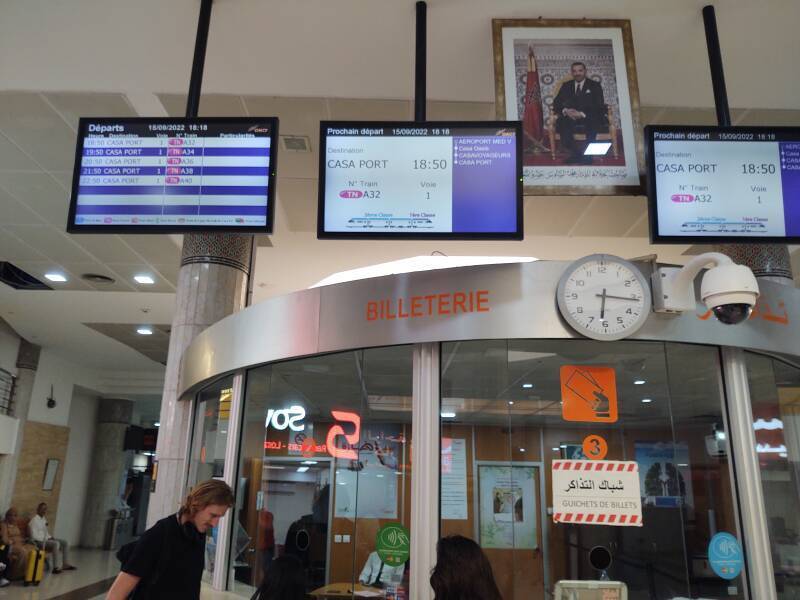
Casa is the standard Moroccan nickname for Casablanca. Its main long-distance train station is Casa Voyageurs. I want to go to Casa Port, next to the large and busy port.
There's a train every hour, a ticket in the First-Class car was just 70 dh.
I was following the excellent advice of The Man in Seat 61, who said (and I agree) that the Moroccan trains are excellent, and the slight surcharge for first class is well worth it.
Here I go: toilets, station chief, and prayer room to the right; platforms straight ahead.
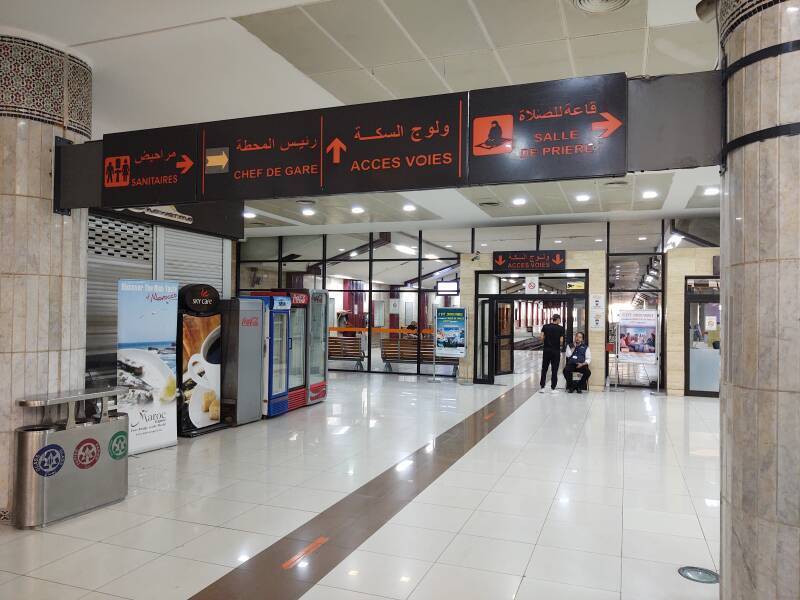
I had a short wait on a bench along platform 1.
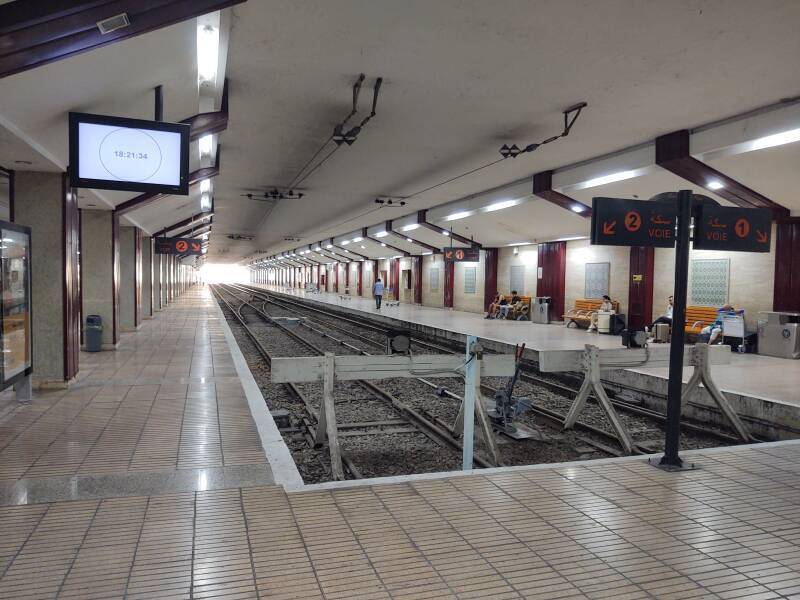
My train to Casa Port has arrived!

Comfortable seats, plenty of room.
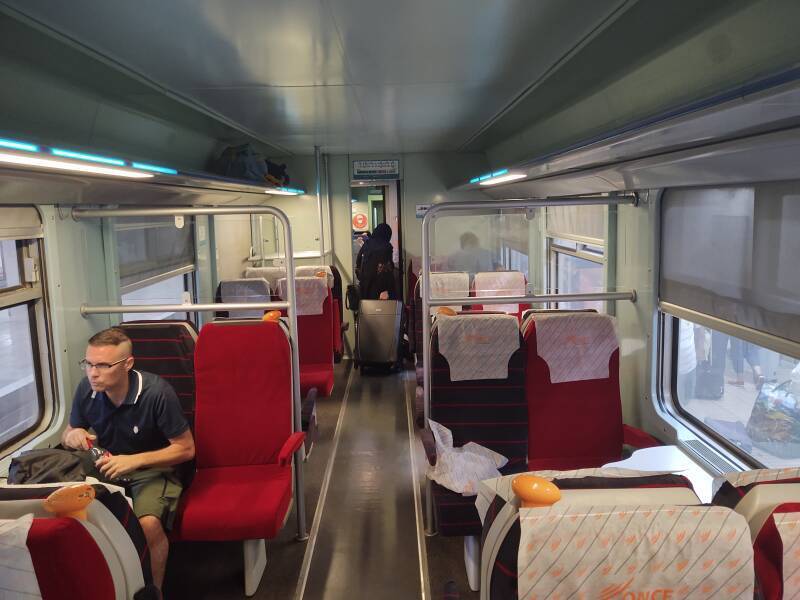
PHP does the math:
<?php echo(date("Y")-1987); ?>
Wow, what a nice train station! This is a modern transport hub, not something out of a 38-year-old movie. From here I had a walk of just 550 meters to where I stayed. In Casablanca I stayed near the train station. Everywhere else I stayed in the medina, the old town, the market district with narrow twisting passageways.

I had a room reserved at the Hotel Moroccan House. What an opulent lobby! The mezzanine above it is where breakfast, lunch, and dinner are served.
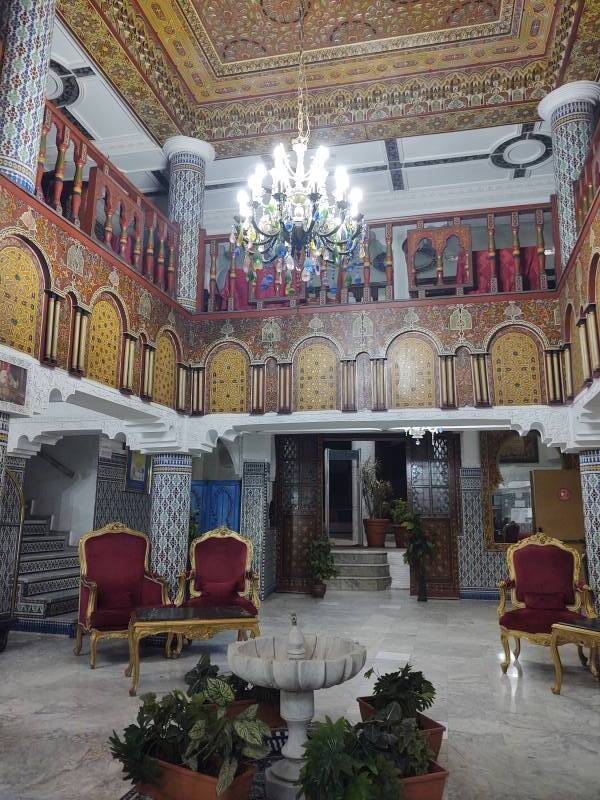
Here's my room. This was just US$ 30 per night through Booking.com.

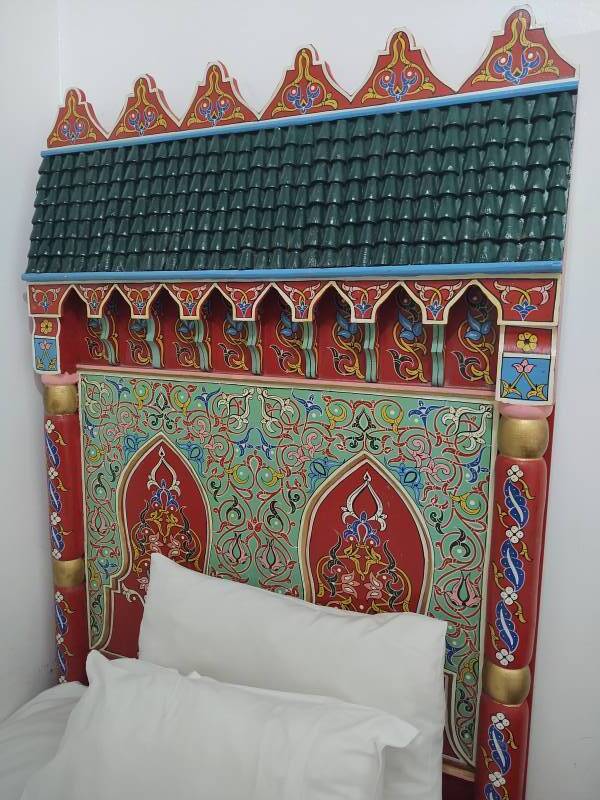
I was seeing that Moroccan design has a lot of detail.

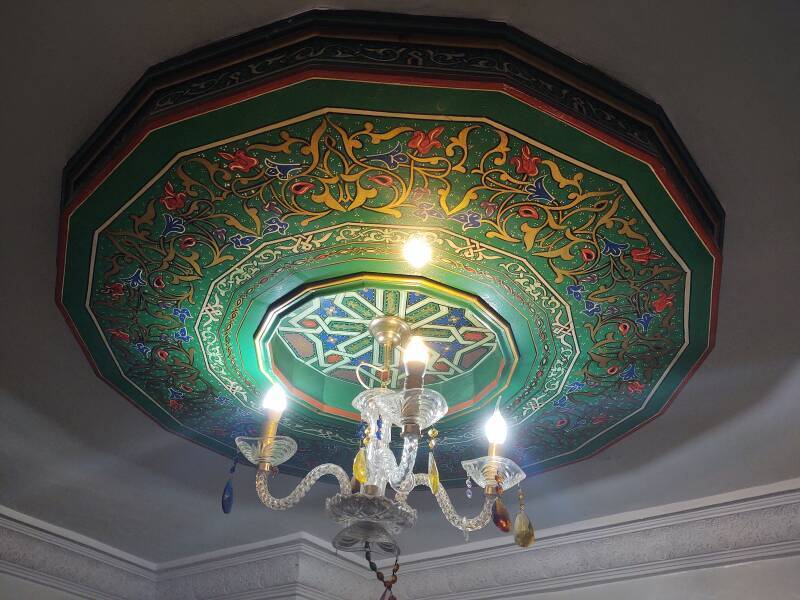
The bathroom included a bidet and a shattaf, a sprayer on a hose.
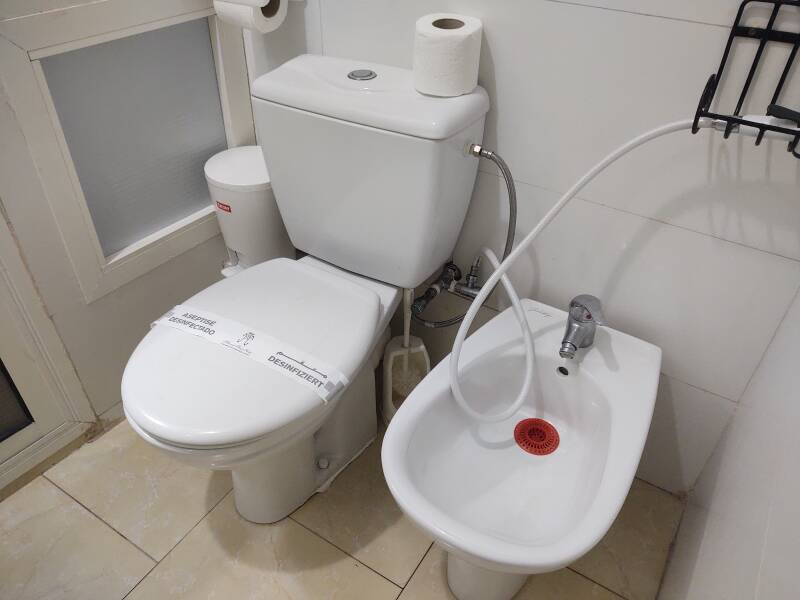
I got some fruit, a piece of cheese, and a 5-liter bottle of water at a supermarket two blocks up the street. I had a late makeshift dinner, turned on the air conditioning and set an alarm on my phone, and went to bed. The overnight flights always leave me in bad shape.
In the morning I was ready to get started.
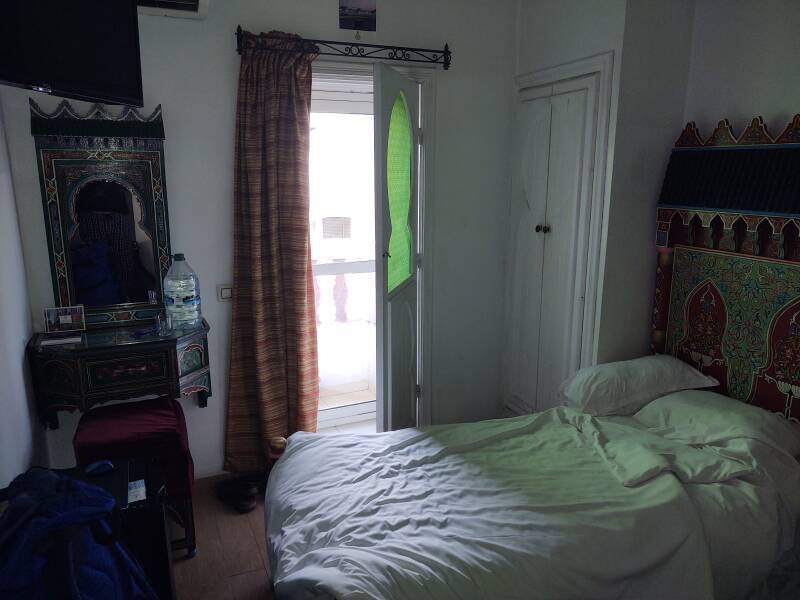
I had a much better view off my balcony in the morning. They're adding another tram line that will run down the street in front of the hotel, joining the main tram line to the Casa Port train station.
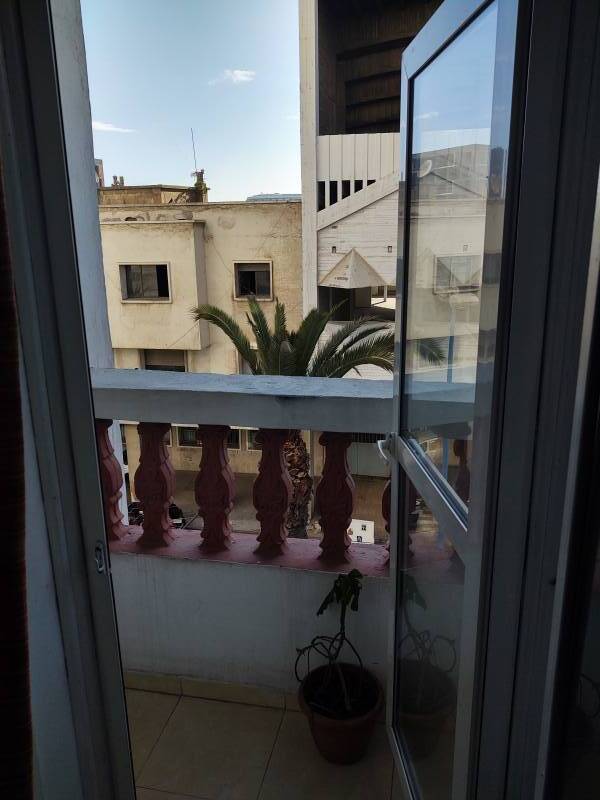
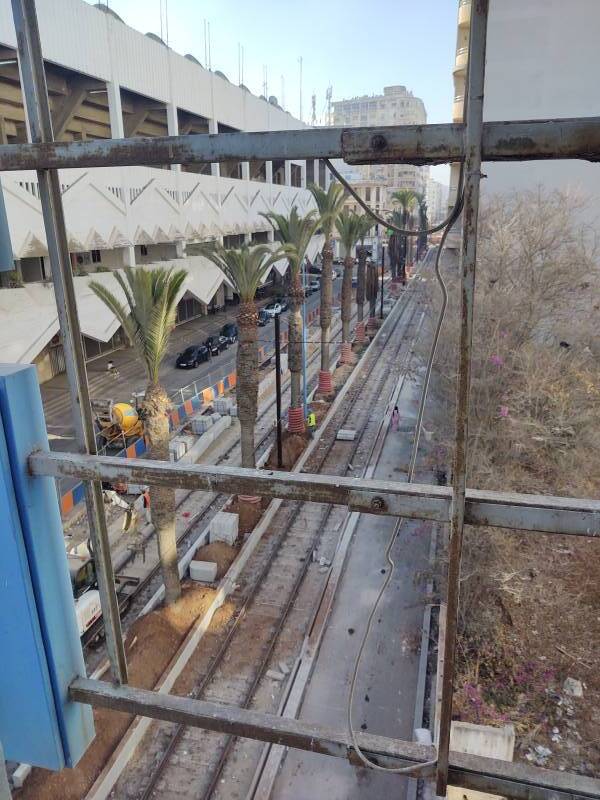
I got breakfast downstairs in the morning.

Then I was ready to start exploring Casablanca.

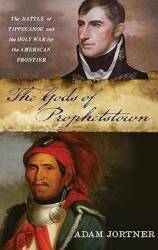
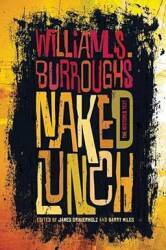
At the time:
1 Dirham = 0.093 US$
10.75 Dirham = 1 US$
or, close enough:
10 Dirham ≈ 1 US$